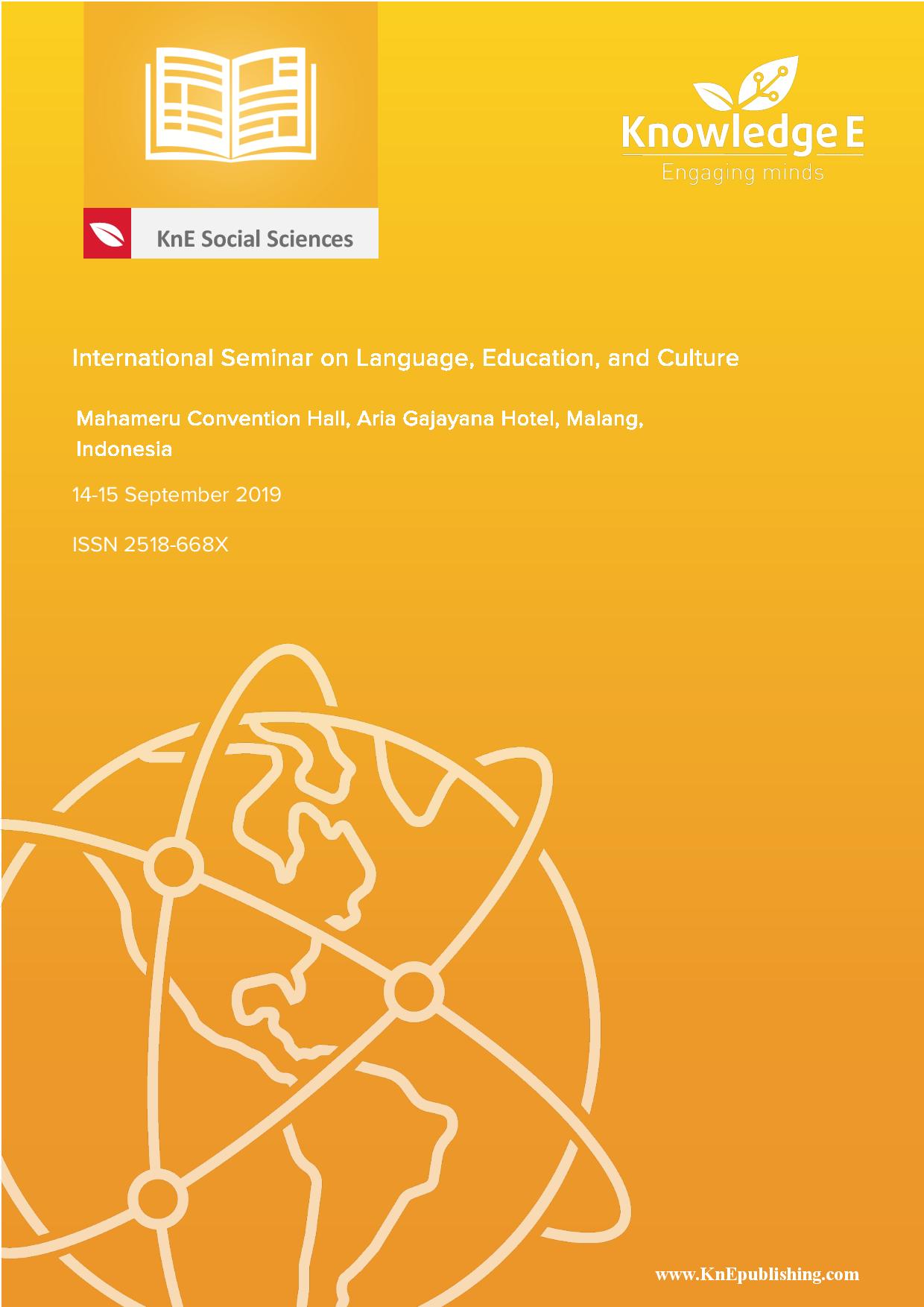Digitalization of Indonesian Culture: The 3-Dimentional Model of the “Patih” Character in Topeng Malang
DOI:
https://doi.org/10.18502/kss.v4i4.6460Abstract
The culture of Malang City cannot be separated from the traditional arts that exist therein.OfthefamousonesisTopengMalang, although it is now not as attractive as the modern art.TopengMalangispeculiarinthatithas67formsofmaskdesign.One way to preserve the Topeng Malang culture, especially regarding mask design, is through digitizing. This research focuses on digitizing the whole form of the Topeng Malang, especially the Patih character, in addition to developing these characters into human formwith3-dimensional modeling techniques.This is a descriptive procedural research model, resulting in a product. Data were obtained thtough observation, interviews and documentation. Observation collected visual data with regard to Topeng Malang’s forms, references for re-forming the Patih character, literature and survey result. The character re-formation applied to patterns, shapes and colors of the Topeng Malang. EnhancingthedesignofthePatihcharacterinTopengMalangassetswillrevitalizethe local wisdom in Malang and improve the recognition, pride, and image of Indonesian culture in the world. This result of this research can also be utilized as part of the materials for character education.
Keywords: Topeng Malang, 3D model, Patih character
References
Astrini, W., Amiuza, C. B., & Handajani, R. P. (2013). Semiotika Rupa Topeng Malangan (Studi Kasus: Dusun Kedungmonggo, Kec. Pakisaji, Kabupaten Malang). Jurnal RUAS, 11(N0 2). https://www.researchgate.net/publication/323479394_Semiotika_Rupa_Topeng_Malangan_Studi _Kasus_Dusun_Kedungmonggo_Kec_Pakisaji_Kabupaten_Malang
Borg, W. R., & Gall, J. P. (2003). Educational Research: An Introduction, 6th Edition. Diambil dari https://www.pearson.com/us/higher-education/product/Gall-Educational-Research-An-Introduction-7th-Edition/9780321081896.html
B.H. McCormick, T.A. DeFanti and M.D. Brown (Eds.). 1987. Visualization in Scientific Computing, ACM SIGGRAPH Computer Graphics, 21, 6.
Cooper, Alan. About Face 3. The Essentials of Interaction Design, ISBN 978-0470084113, www. newsrider.com, USA, 2008
G.S. Owen. 1999. HyperVis:Teaching Scientific Visualization Using Hypermedia. ACM SIGGRAPH Education Committee., http://www.siggraph.org/education/materials/HyperVis/hypervis.htm
Carmigniani, J., Borko, F., Marco, A., Paolo, C., Ernesto, D., & Misa, I. (2011). Augmented reality technologies, systems and applications. Multimedia Tools and Applications, Volume 51(Issue 1), pp 341–377.
Damiani, L., Demartini, M., Guizzi, G., Revetria, R., & Tonell, F. (2018). Augmented and virtual reality applications in industrial systems: A qualitative review towards the industry 4.0 era. IFAC-PapersOnLine, Volume 51(Issue 11), Pages 624-630. https://doi.org/10.1016/j.ifacol.2018.08.388
Hidajat, R. (2005). STRUKTUR, SIMBOL, DAN MAKNA WAYANG TOPENG MALANG. Jurnal BS, volume 2. Diambil dari http://sastra.um.ac.id/wp-content/uploads/2009/10/Struktur-Simbol-dan-Makna-Wayang-Topeng-Malang-Robby-Hidajat.pdf
Hoekman, Robert, Designing the Moment: Web Interface Design Concepts in Action,www.newsrider. com, USA, 2008
Hariyanto, Guruh, Definisi Visualisasi,Animasi dan Simulasi, http://guruh-al-horford-fst08.web.unair.ac. id/, 2011
Hsin-Kai, W., Silvia Wen, Y., Hsin-Yi, C., & Jyh-Chong, L. (2013). Current status, opportunities and challenges of augmented reality in education. Computers & Education, Volume 62, Pages 41-49. https://doi.org/10.1016/j.compedu.2012.10.024
Lee, K. (2012). Augmented Reality in Education and Training. TechTrends, Volume 56(Issue 2), pp 13–21. https://doi.org/10.1007/s11528-012-0559-3
Kieven, L. (2015, October). Simbolisme Cerita Panji dalam Relief-Relief di Candi Zaman Majapahit dan Nilainya Pada Masa Kini. In Makalah ini disumbangkan dalam acara ‘Cerita Panji Sebagai Warisan Budaya Dunia, Seminar Naskah Panji’di Perpustakaan Nasional Republik Indonesia ( Jakarta, 28 dan Oktober 2014). Diakses pada (Vol. 11).
Manuaba, I. B. (2013). Keberadaan dan Bentuk Transformasi Cerita Panji. LITERA, 12(1).
M.A. Hearst. 2009. Search User Interfaces, Cambridge University Press.
Minarto, S. W. (2008). Struktur Simbolik Tari Topeng Patih Pada Pertunjukan Dramatari Wayang Topeng Malang Di Dusun Kedungmonggo Desa Karangpandan Kecamatan Pakisaji Kabupaten Malang. https: //lib.unnes.ac.id/16743/.
Müller, N. M., & Tina, S. (2018). “Effects of Self-Regulation Prompts in Hypermedia Learning on Learning Performance and Self-Efficacy,.” Learning and Instruction, 58, 1–11. https://doi.org/10.1016/j.learninstruc. 2018.04.011.
Nincarean, D., Alia, M. B., Halim, N. D. A., & Rahman, M. H. A. (2013). Mobile augmented reality: the potential for education. 13th International Educational Technology Conference, 103, 657–664. https: //doi.org/10.1016/j.sbspro.2013.10.385
Pramono, A. (2013). Media Pendukung Pembelajaran Rumah Adat Indonesia Menggunakan Augmented Reality. Jurnal ELTEK, Vol 11 No 1. http://eltek.polinema.ac.id/index.php/eltek/article/view/10
Rahayuningtyas, W. (2013). Pengemasan Bahan Ajar Tari Topeng Malang Pada Mata Kuliah Vokasi Tari Malang. Journal Harmonia: Journal of Arts Research and Education, 13(1). https://journal.unnes.ac.id/ nju/index.php/harmonia/article/view/2530
Sutopo, A.H.2002. Analisis dan Desain Berorientasi Objek. Yogyakarta: J&J Learning
Setiawan, Sandi. 1991, Teknik Pemrograman, Yogyakarta: ANDI
Tay, Vaughan. 2004. Multimedia: Making It Work Edisi 6. Yogyakarta: ANDI

